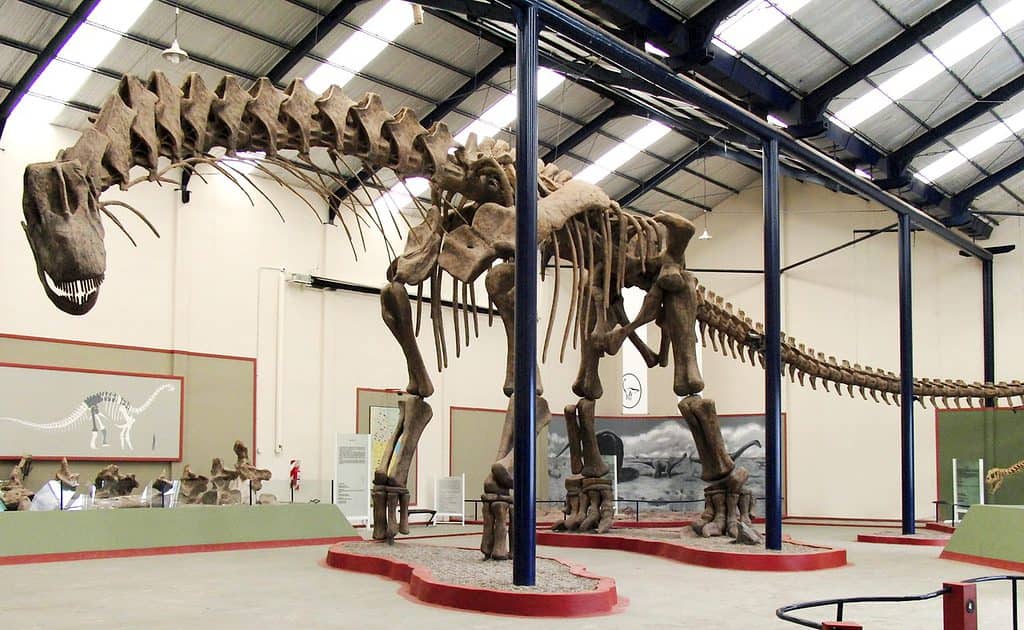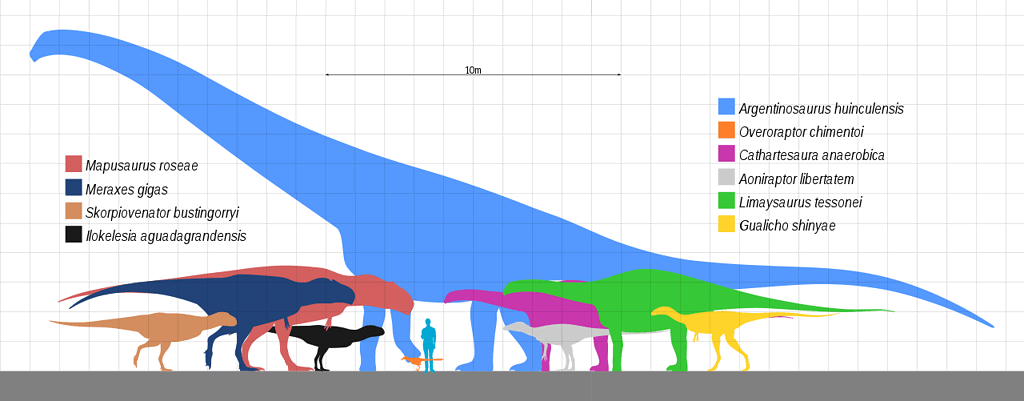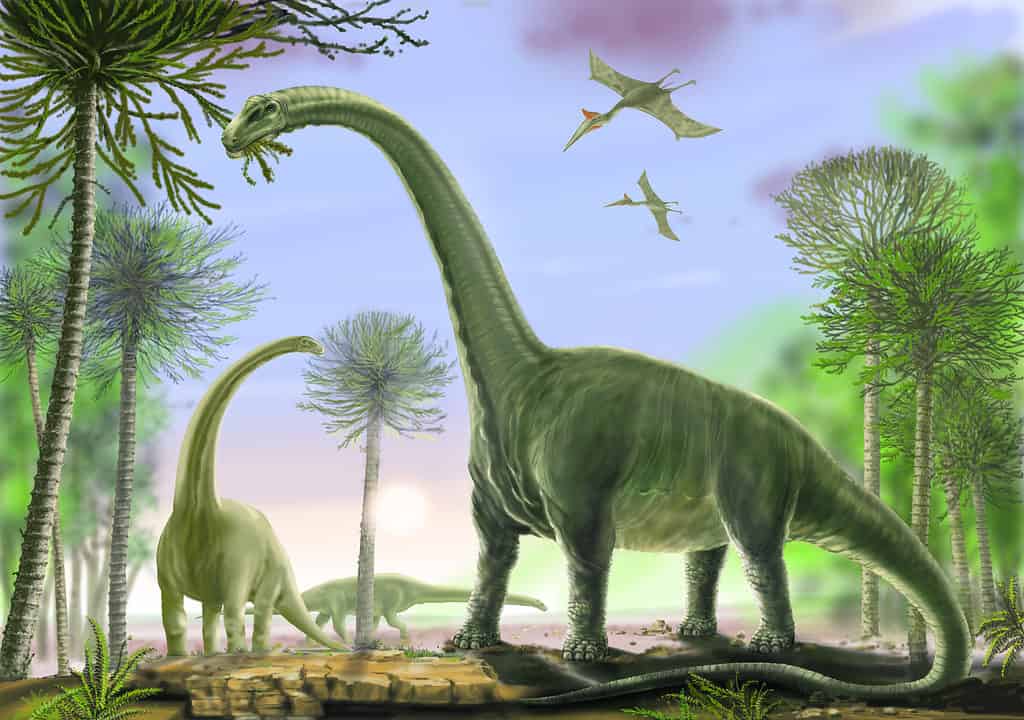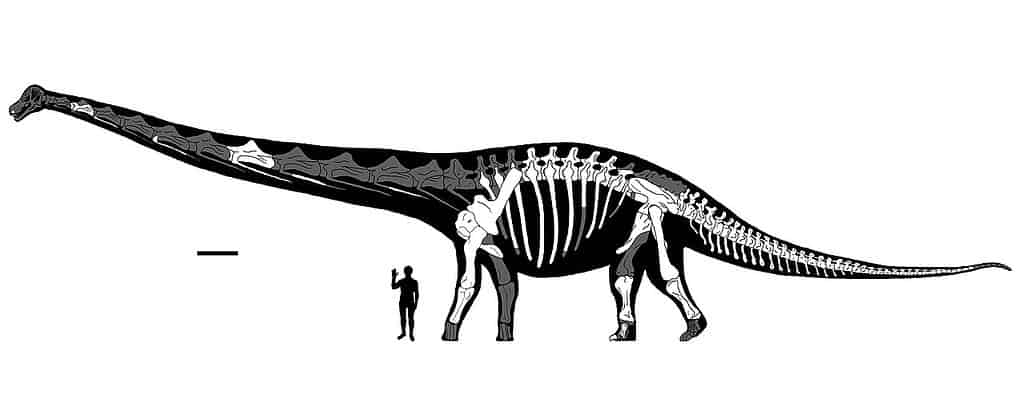What’s the biggest dinosaur to have roamed the planet? Debates surrounding this topic are never-ending, but if there’s one type of dinosaur that comes close to tipping the scales, it must be the Argentinosaurous.
The 1987 discovery of Argentinosaurous fossils in the Argentine Province of Neuquén rocked the world of paleontology. The length and weight of its remains indicate that it could have been the largest animal in the world.
So what do we know about the Argentinosaurus? Where does it come from, did it have predators, and if it were alive today, could this giant lizard tower over buildings? The short answer to the last question is, most definitely. For the rest, there’s much to unpack about this giant reptile.
Overview of the Argentinosaurus

©William Irvin Sellers, Lee Margetts, Rodolfo Aníbal Coria, Phillip Lars Manning / CC BY 2.5, via Wikimedia Commons – License
The Argentinosaurous is classified as a titanosaur because of its immense size. It’s also said to be related to sauropods, a group of long-necked, large herbivores dominating the Jurassic period.
Archeological evidence suggests that the Argentinosaurous existed 145 to 66 million years ago, during the Cretaceous period. Evolution was occurring rapidly at this stage, with diversity among dinosaurs at an all-time high.
For this reason, Argentinosaurous lived among various types of armored, thick-skulled, long-tailed herbivores and carnivores. The Gigantosaur, a meat-eating dinosaur comparable to the Tyrannosaurus Rex, existed at the same time and territory as the Argentinosaurous, indicating they had a predator-prey relationship.
Size of the Argentinosaurous

©User:Slate Weasel / public domain – License
Although opinions are divided about the size of Argentinosaurous, the dinosaur could have measured between 80 and 130 feet long and weighed between 30 and 70 tons.
This disagreement is driven by the incomplete and insufficient nature of the skeletons found. To date, paleontologists have only unearthed a small collection of vertebrae, ribs, and a massive four-foot femur bone.
While some scientists argue that the size of the Argentinosaurous can be accurately determined by comparing its remains to the more in-depth fossilized material of other sauropods found, others say that we need further evidence to form a complete picture.
How Big Was Argentinosaurous Compared to Animals Today?
While its size is debatable, the Argentinosaurous was unfathomably big. Put to scale, the size of a dinosaur is similar to a blue whale, the planet’s largest ocean-dwelling animal. However, although its length is equivalent to whales, its height is four times greater.
Argentinosaurous Characteristics

©David Roland/Shutterstock.com
There’s still a lot we don’t know about this enormous sauropod, but scientists have learned many interesting facts since its discovery. Some are listed below.
1. Argentinosaurous Eggs Were Estimated To Be Large
These fossils haven’t been unearthed, but Argentinosaurous eggs were surely pretty sizeable, predicted to reach a foot in diameter.
Females laid 12 to 15 eggs at a time, increasing the odds that at least one hatchling would survive until adulthood with many predators afoot.
2. Argentinosaurous Grew for a Large Portion of Their Lives
We don’t know much about the average lifespan of an Argentinosaurous, but scientists put that number anywhere between 30 and 100 years. Argentinosaurous spent much of that time growing.
According to experts, these and other sauropods and titanosaurs grew incrementally, with some taking between 15 and 40 years to reach their full size.
3. Argentinosaurous Spent a Large Amount of Time Eating
Because of its heft, it shouldn’t surprise anyone that Argentinosaurous ate immensely to sustain their energy. To comprehend the daily amount they might have consumed, let’s compare their eating habits with elephants, today’s largest land mammals.
Weighing between two to seven tons, elephants eat 330 to 375 pounds of food daily. Comparing the weight of a big elephant (seven tons) to a big Argentinosaurous (70 tons), the latter would probably require ten times more food, averaging between 3000 to 3750 pounds daily.
Argentinosaurous were herbivores that might have grazed on low-lying plants or nibbled the leaves of trees. Although vegetation made up most of their diet, they could have also eaten nuts and fruit.
4. Argentinosaurous Had Long Necks
Forget giraffes; Argentinousaurous had extremely long necks. Because of incomplete fossil remains, we don’t know the exact length of their necks, but they probably extended to 29 feet.
Their necks might have helped them reach the food they needed to survive. However, whether this dinosaur stretched their necks to nibble on plant leaves or bent over to forage off the ground is an unsolved mystery.
5. Argentinosaurous Were Slow Moving
Argentinosaurous were very slow-moving creatures – which is unsurprising if you consider their bulk. They’d reach a maximum speed of five miles per day.
Although slow, Argentinosaurous probably caused plenty of structural damage underfoot, shaking the earth as they moved.
Additionally, they likely congregated in herds, causing further destruction in their wake, especially if predators were hunting them down. Today, they’d crush six-foot-story buildings that were in the way effortlessly.
6. They Had Enemies
Argentinosaurous’ size didn’t stop them from having enemies and predators. As we mentioned earlier, Giganotosaurus existed at the same time and territory as the Argentinosaurous.
The eight to 10-ton carnivorous dinosaur, which belonged to a larger group of theropods, wasn’t a likely match against the mega-ton Argentinosaurous. This leads us to believe that the Giganotosaurus hunted in packs to bring down larger prey.
Are There Other Dinosaurs Vying for the World’s Biggest Dinosaur Position?

©ArcaneHalveKnot / CC BY-SA 4.0, via Wikimedia Commons – License
At this point, there’s no way to know, without a measure of a doubt, that the Argentinosaurous is the biggest dinosaur and land animal to have ever existed. And while scientists continue to figure that out, other dinosaurs are gunning for the top position.
Dreadnoughtus, which means fear nothing, is aptly named. Also belonging to the titanosaurs family, it dominated international headlines in 2005 after being discovered in Patagonia, Argentina. The mega-sized dinosaur, described as astoundingly big, is said to have weighed as much as a dozen elephants or seven T-rexes and lived without fear of predators. At 85 feet long and 65 tons, the skeletal remains uncovered were that of a juvenile dinosaur, leading many to believe that at full size, Dreadnoughtus could dwarf Argentinosaurous.
Another contender is the Bruhathkayosaurus, Greek for a huge-bodied lizard, that came from India. It probably was another enormous species of titanosaurs, but this has yet to be 100% confirmed. Although fossils found are fragmented, what has been uncovered is a leg bone bigger than that of an Argentinosaurus leg bone. With those pieces of the puzzle, Bruhathkayosaurus might have been 150 feet long and weighed 200 tons – although there’s insufficient evidence to prove that in its entirety.
Up Next:
Top Ten World’s Largest Dinosaurs Ever
Discover 12 Modern-Day Animals That Look Like Dinosaurs
What Was The Largest Herbivore Dinosaur?
The post At 115ft Long and Over 70 Tons This Lizard Towers Over Buildings appeared first on AZ Animals.
from Animal News, Facts, Rankings, and More! - AZ Animals https://ift.tt/lN2SwAd